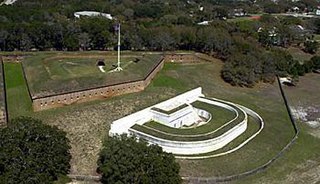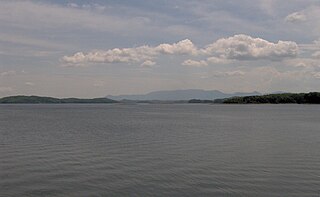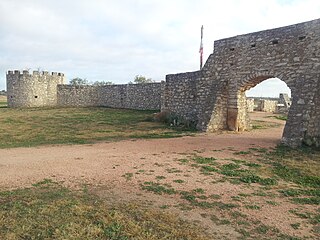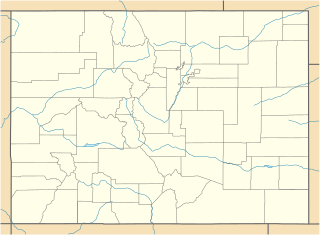 W
WLos Adaes was the capital of Tejas on the northeastern frontier of New Spain from 1729 to 1770. It included a mission, San Miguel de Cuellar de los Adaes, and a presidio, Nuestra Señora del Pilar de Los Adaes. The name Adaes represents the indigenous Adai people, who were to be served by the mission.
 W
WFort Barrancas (1839) or Fort San Carlos de Barrancas is a United States military fort and National Historic Landmark in the former Warrington area of Pensacola, Florida, located physically within Naval Air Station Pensacola, which was developed later around it.
 W
WFort Charlotte, Mobile is a partially-reconstructed 18th-century fort in Mobile, Alabama.
 W
WChiaha was a Native American chiefdom located in the lower French Broad River valley in modern East Tennessee, in the southeastern United States. They lived in raised structures within boundaries of several stable villages. These overlooked the fields of maize, beans, squash, and tobacco, among other plants which they cultivated. Chiaha was the northern extreme of the paramount Coosa chiefdom's sphere of influence in the 16th century when the Spanish expeditions of Hernando de Soto and Juan Pardo passed through the area. The Chiaha chiefdom included parts of modern Jefferson and Sevier counties, and may have extended westward into Knox, Blount and Monroe counties.
 W
WThe Cubo Line was part of the defense system built by the Spanish to protect the presidio of St. Augustine in the territory of Spanish Florida during the early years of the 18th century.
 W
WFort San Francisco de Pupo was an 18th-century Spanish fort on the west bank of the St. Johns River in Florida, about eighteen miles from St. Augustine, the capital of Spanish Florida. Lying on the old trail to the Spanish province of Apalachee in western Florida, Fort Pupo and its sister outpost, Fort Picolata on the opposite shore of the river, controlled all traffic on the ferry crossing. The remains of Fort Pupo are situated about three miles south of Green Cove Springs in Clay County, near the end of Bayard Point opposite Picolata. The surrounding area is a hammock of southern live oak, southern magnolia, pignut hickory and other typical trees native to the region.
 W
WLa Fortaleza is the official residence of the Governor of Puerto Rico. It was built between 1533 and 1540 to defend the harbor of San Juan. The structure is also known as Palacio de Santa Catalina. It is the oldest executive mansion in continuous use in the New World. It was listed by UNESCO in 1983 as part of the World Heritage Site "La Fortaleza and San Juan National Historic Site".
 W
WFort George was a British fort built in 1778 for the protection of Pensacola, Florida. The Spanish captured it in Siege of Pensacola on May 10, 1781.
 W
WFort Guijarros was a Spanish fort in what is now San Diego, California, USA. The name means "Fort Cobblestones" in English. It was built in 1797 on Ballast Point as the first defensive fortifications for San Diego Bay. It was involved in the Battle of San Diego, a naval battle between the fort and an American trading vessel. The site is registered as California Historical Landmark #69.
 W
WJoara was a large Native American settlement, a regional chiefdom of the Mississippian culture, located in what is now Burke County, North Carolina, about 300 miles from the Atlantic coast in the foothills of the Blue Ridge Mountains. Joara is notable as a significant archaeological and historic site, where Mississippian and European artifacts have been found, in addition to an earthwork mound and remains of a 16th-century Spanish fort.
 W
WFort Matanzas National Monument was designated a United States National Monument on October 15, 1924. The monument consists of a 1740 Spanish fort called Fort Matanzas, and about 100 acres (0.4 km²) of salt marsh and barrier islands along the Matanzas River on the northern Atlantic coast of Florida. It is operated by the National Park Service in conjunction with the Castillo de San Marcos National Monument in the city of St. Augustine.
 W
WFort Mose Historic State Park is a U.S. National Historic Landmark, located two miles north of St. Augustine, Florida, on the edge of a salt marsh on the western side of the waterway separating the mainland from the coastal barrier islands. The original site of the 18th-century fort was uncovered in a 1986 archeological dig. The 24-acre (9.7 ha) site is now protected as a Florida State Park, administered through the Anastasia State Recreation Area. Fort Mose is the "premier site on the Florida Black Heritage Trail". In 1738, the Spanish governor of Florida, Manuel de Montiano, had Fort Mose built and established as a free black settlement, the first to be legally sanctioned in what would become the territory of the United States. The fort has also been known as Fort Moosa or Fort Mossa, variants of the Spanish pronunciation.
 W
WFort Point is a masonry seacoast fortification located on the southern side of the Golden Gate at the entrance to San Francisco Bay. It is also the geographic name of the promontory upon which the fort and the southern approach of the Golden Gate Bridge were constructed.
 W
WA presidio is a fortified base established by the Spanish in areas under their control or influence. The term is derived from the Latin word praesidium meaning protection or defense.
 W
WThe Presidio Nuestra Señora de Loreto de la Bahía, known more commonly as Presidio La Bahía, or simply La Bahía is a fort constructed by the Spanish Army that became the nucleus of the modern-day city of Goliad, Texas, United States. The current location dates to 1747.
 W
WPresidio de Béxar was a Spanish fort built near the San Antonio River, located in what is now San Antonio, Texas, in the United States. It was designed for protection of the mission San Antonio de Valero and the Villa de Bejar. The Presidio de Bejar was founded on May 5, 1718 by Spanish Governor Martin de Alarcon and his 35 Presidio Soldiers. The Villa de Bejar is known for being the first Spanish settlement of San Antonio and consisted of the families of the Presidio Soldiers and those of the prior expeditions. It also served to secure Spain's claim to the region from French, English and American aggression.
 W
WPresidio San Luis de las Amarillas, now better known as Presidio de San Sabá, was founded in April 1757 near present-day Menard, Texas, United States to protect the Mission Santa Cruz de San Sabá, established at the same time. The presidio and mission were built to secure Spain's claim to the territory. They were part of the treaty recently reached with the Lipan Apaches of the area for mutual aid against enemies. The early functioning of the mission and presidio were undermined by Hasinai, also allied with the Spanish, attacking the Apaches. The mission was located three miles downstream from the presidio by request of the monks at the mission to ensure that the Spanish soldiers would not be a corrupting influence on the Lipan Apaches the monks were trying to convert to Christianity. The original presidio and mission were built out of logs.
 W
WThe Presidio Santa María de Galve, founded in 1698 by Spanish colonists, was the first European settlement of Pensacola, Florida after that of Tristan de Luna in 1559-1561. It was in the area of Fort Barrancas at modern-day Naval Air Station Pensacola, in northwestern Florida. The presidio included Fort San Carlos de Austria and an adjacent village.
 W
WFort San Carlos was a military structure built in 1816 to defend the Spanish colonial town of Fernandina, Florida, now called Old Town, which occupied a peninsula on the northern end of Amelia Island. The fort, a lunette fortification, stood on the southwest side of the town next to the harbor, on a bluff overlooking the Amelia River. It was made of wood and earthworks, backed with a wooden palisade on the east side, and armed with an eight or ten gun battery. Two blockhouses protected access by land on the south, while the village was surrounded with military pickets. An 1821 map of Fernandina shows that the street plan, laid out in 1811 in a grid pattern by the newly appointed Surveyor General of Spanish East Florida, George J. F. Clarke, today preserves nearly the same layout as that of 1821. The fort occupied the area bounded by the streets Calle de Estrada, Calle de White, and Calle de Someruelos. The structure itself has disappeared and only traces remain in what is now Fernandina Plaza Historic State Park.
 W
WFort San Juan was a late 16th-century fort built by the Spanish under the command of conquistador Juan Pardo in the native village of Joara, in what is now Burke County, North Carolina. Used as an outpost for Pardo's expedition into the interior of what was known to the Spaniards as "la Florida", Fort San Juan was the foremost of six forts built and garrisoned by Pardo in modern-day North Carolina, South Carolina, and Tennessee to extend Spain's effective control deeper into the North American continent.
 W
WThe Castillo de San Marcos is the oldest masonry fort in the continental United States; it is located on the western shore of Matanzas Bay in the city of St. Augustine, Florida. The Castillo was designed by the Spanish engineer Ignacio Daza, with construction beginning in 1672, 107 years after the city's founding by Spanish Admiral and conquistador Pedro Menéndez de Avilés, when Florida was part of the Spanish Empire. The fort's construction was ordered by Governor Francisco de la Guerra y de la Vega after a raid by the English privateer Robert Searles in 1668 that destroyed much of St. Augustine and damaged the existing wooden fort. Work proceeded under the administration of Guerra's successor, Manuel de Cendoya in 1671, and the first coquina stones were laid in 1672. The construction of the core of the current fortress was completed in 1695, though it would undergo many alterations and renovations over the centuries.
 W
WA Spanish military fort was constructed and occupied in 1819 near Sangre de Cristo Pass in the present U.S. State of Colorado to protect the Spanish colony of Santa Fe de Nuevo México from a possible invasion from the United States. The fort was the only Spanish settlement in present-day Colorado. The site of this fort is known today as the Spanish Fort.
 W
WSpanish Fort, also known as Old Spanish Fort, Fort St. Jean, and Fort St. John, is a historic place in New Orleans, Louisiana, formerly the site of a fort and later an amusement park.
 W
WFort St. Philip is a historic masonry fort located on the eastern bank of the Mississippi River, about 40 miles (64 km) upriver from its mouth in Plaquemines Parish, Louisiana, just opposite Fort Jackson on the other side of the river. It formerly served as military protection of New Orleans, some 80 miles (130 km) up the river, and of the lower Mississippi River.